Isaac Julien's 'Once Again... (Statues Never Die)': A Timely Reminder for Art Historians Amidst Current Debates in Art History”
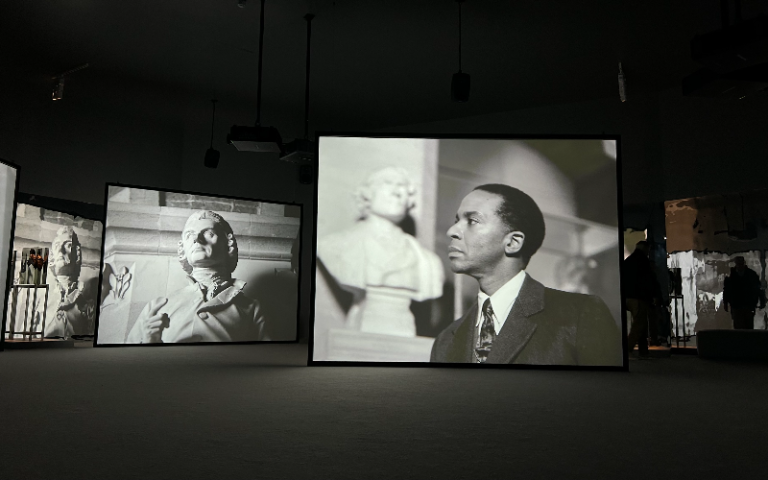
Isaac Julien, photo taken from Once Again… (Statues Never Die), 2022, five screen film installation, display in What Freedom Is To Me at Tate Britain
Isaac Julien’s exhibition What Freedom Is To Me at Tate Britain acts as a conversation between art and viewer. The exhibition is designed for viewers to reflect on their role in society, reflect on their privileges, reflect on what has not changed and reflect on what could change. What Freedom Is To Me, comprising of 7 films created by Isaac Julien, explores key themes of nationality, identity and racial imbalance within the art world. Although this article will analyse What Freedom Is To Me as an exhibition, the primary focus will remain on Julien’s film Once Again… (Statues Never Die). This film serves as a powerful visual reminder to art historians of the crucial current debates in art history. This film challenges the historical classifications of art, colonial histories and racial hierarchies that have dominated the western canon of art. This film, in its context of its exhibition in the year 2023, highlights to art historians the work that is yet still to be done and acts as an example of the power art has to bring change to a dominant narrative.
Entering the exhibition What Freedom Is To Me
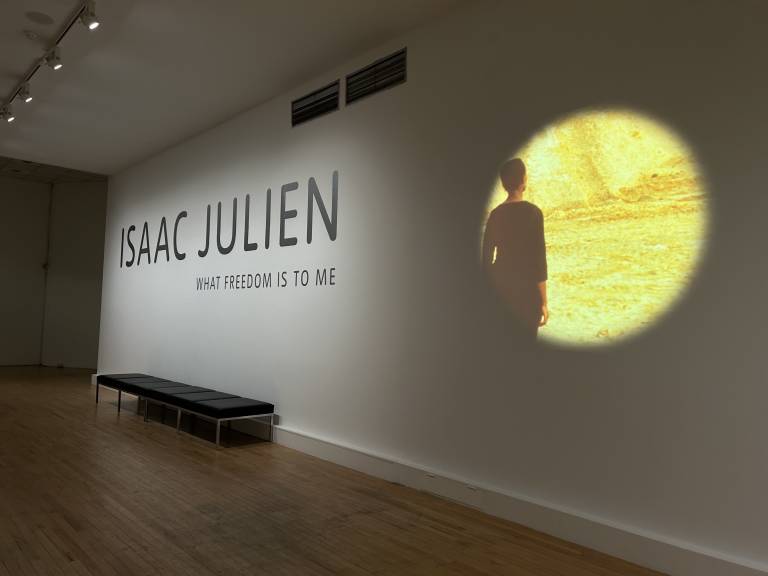
Right: Isaac Julien, video taken from Once Again… (Statues Never Die), 2022, five screen film installation, display in What Freedom Is To Me at Tate Britain
Once entering the exhibition, the viewer is instantly submerged into the film Once Again… Statues Never Die (2022) - one of Julien’s most recent films. The room is blacked out from any natural light and the viewer is taken away from reality and into a world of Julien’s artistry. The film installation is primarily black and white and is presented with five upright screens displaying differing scenes. Emotionally charged music floods the room and elevates the visuals to a higher form of art. Julien presents the viewer in a museum space and focuses on examining public statues and their symbolic and historical significance.
In this film, Julien invites the viewer to confront the underlying realities that surround these monuments and uncover the hidden histories and narratives that have been suppressed. This film acts as a visual examination of how these monuments have been a method to uphold dominant narratives of imperialism and colonialism. Notably, the exhibition leaflet describes that “with the inclusion of sculptures…the installation alludes to contemporary restitution debates, examining the collection, display and significance of African visual culture in western museums.” Most importantly the leaflet indicates to the viewer that the film “reflects on Locke’s lifelong mission to reorient the aesthetic compass of the African diaspora in the direction of its rightful artistic heritage.”
Communication and Conversation
One of the most central themes within this film is communication and conversation. As mentioned in the exhibition leaflet, “the film centres on a conversation between Alain Locke (1885-1954), the philosopher, educator, and cultural theorist of the Harlem Renaissance, and Albert C. Barnes (1872-1951), an early us collector and exhibitor of African material culture.” Throughout the film, moments of key conversations are shown between the two individuals that talk about their differing perceptions on how African art is collected within European collections and questions the pre-existing classifications of art. An art historian observing this film may observe this conversation more metaphorically as a representation between more contemporary approaches to art history in contrast to the older dominant views of art history - one that prioritises a postcolonial approach, and one that upholds imperialism and the western canon of art.
Julien’s use of film provides a sensory experience - a medium for change
Julien also claims using “aesthetics, poetry, movement, and music as a medium” is important for his storytelling. Music and sound are the driving force of this work. Alice Smith (singer/songwriter) is featured in the film providing powerful vocals throughout the film. A viewer watching the film in this space engages in a sensory experience with light flickering from harsh white light bouncing from the white carpeted floors to sudden darkness accompanied by astoundingly beautiful singing. Floors and walls vibrate almost unable to contain themselves from the magnitude of emotion dissipating from the film. By intertwining these artistic mediums, the exhibition effectively conveys the emotional effects of African art’s appropriation within art history. The film’s incorporation of powerful music not only creates a strong artistic piece of work but evokes an emotional response within the viewer. The film utilises this dynamic medium to confront prevailing forces that still dominate discussions in art history. As a result, the film offers a profound emotional journey, allowing the viewer to be truly seen and moved.
Moving through the rest of Tate Britain’s exhibition What Freedom Is To Me
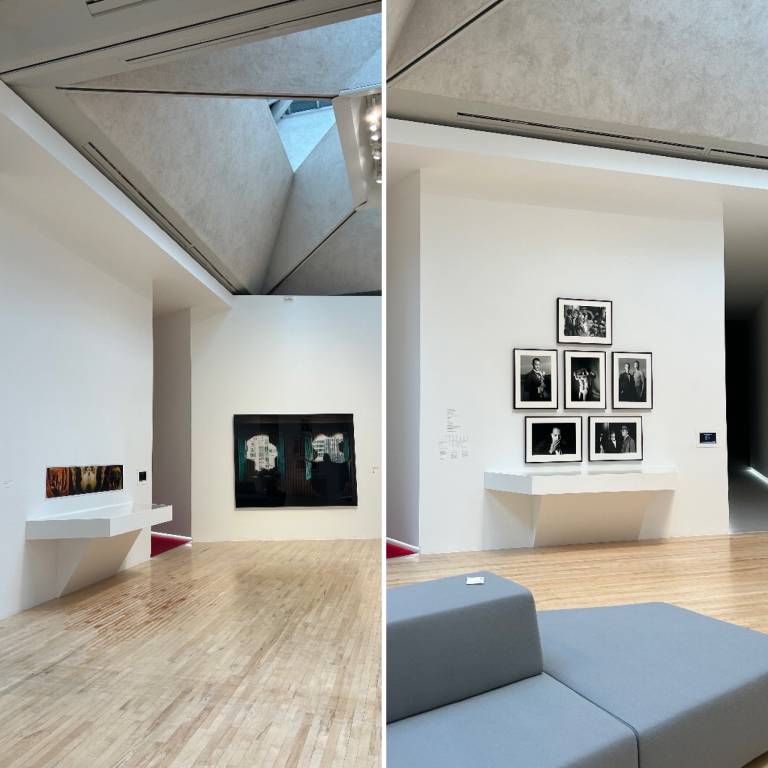
Left and Right: Photos taken inside What Freedom Is To Me
Continuing through the exhibition Freedom Is To Me, it is evident that Julien designed this space to prompt a viewer to look at the past as a way of viewing and analysing the present.
Once the viewer then completes watching Once Again… (Statues Never Die), the viewer is then presented into the heart of the exhibiting space, a central point devoid from the outside world. The viewer is presented with 6 hallways leading to the 7 different films of Julien’s all on display. These films vary in their focus with some themes of nationality, identity, and sexuality. Julien worked with influential architect David Adjaye to design a space where time collapses and a viewer is suspended within a materialised exhibition of thoughts and feelings. This exhibiting space intends to strip the audience from the real world and from time itself. The viewer can walk into which ever room they choose, and watch films created at varying points of Julien’s career. This makes a viewer blur different time points together and evaluate all works as if they were all created in unison in the present.
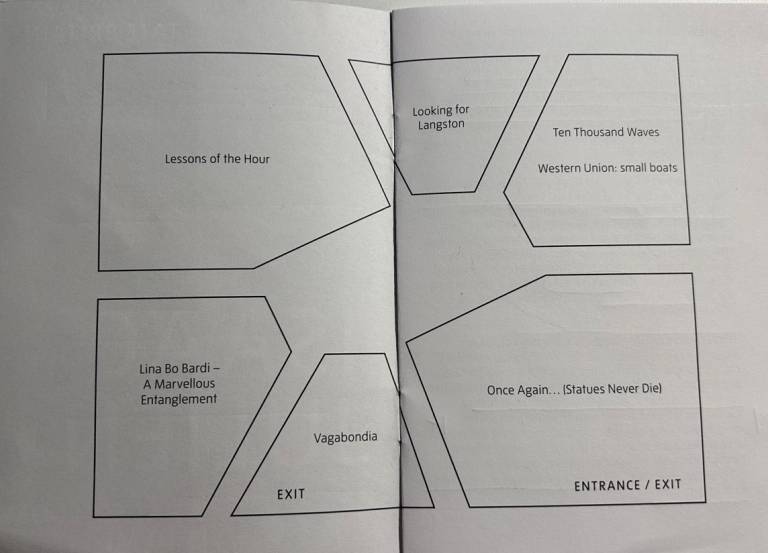
Photo of exhibition floor plan in exhibition leaflet
To leave the exhibition the viewer could leave through a provided exit through the film Vagabondia, or more significantly return through Once Again… (Statues Never Die). This suggests that Julien is promoting a viewer to watch films not just once, but repetitively. By rewatching Once Again… (Statues Never Die), a viewer can then draw links from films they have just watched such as Looking for Langston and Lessons of the Hour and apply these newfound perspectives to the film. The choice to start and end the exhibition with the same film is a significant choice that highlights Julien’s value and geared importance of this film.
How is Once Again… (Statues Never Die) situated within the rest of the contemporary art sphere?
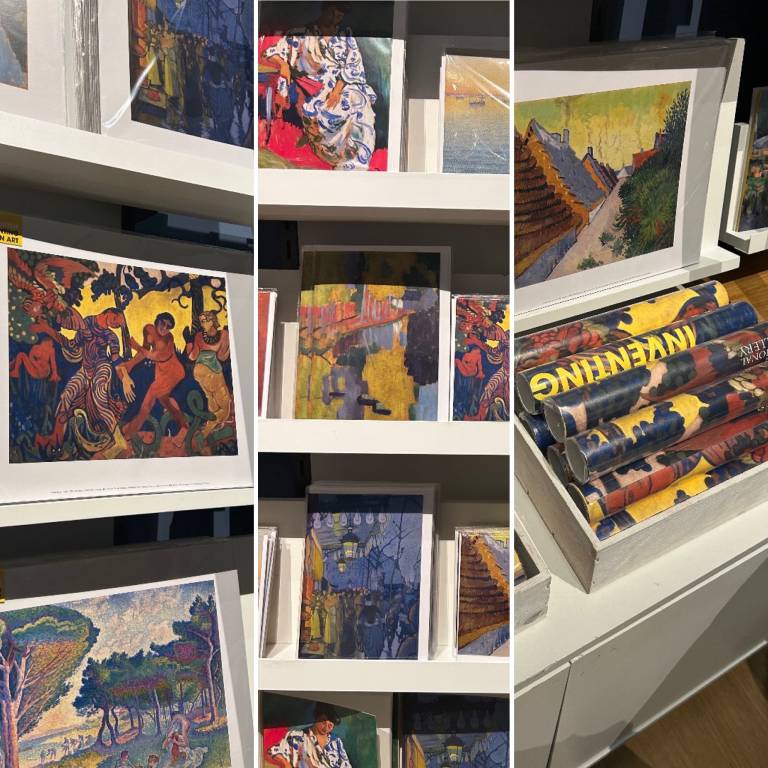
Photos taken inside After Impressionism: Making of Modern Art shop
The National Gallery's exhibition Inventing Impressionism: The Making of Modern Art showcases modernist artworks like Picasso and Modigliani, which are referenced in the film Once Again… Statues Never Die. The exhibition successfully acknowledges that many modernist artists exploited African art for their own decontextualized artistic benefit. However, the exhibition's self-awareness is limited due to contradicting messages. For example, the exhibition recognises, in the provided commentary, that André Derain's 1906 The Dance has been influenced by a range of decontextualised cultural influences. In contrast to the commentary, the exhibition chose to use this painting as one of the central works used for advertising merchandise in the shop. This suggests that the modern and contemporary sphere could be still upholding these older ideals by potentially capitalizing off these exploitations. This highlights the urgency of Julien's film in the contemporary sphere, which is limited in providing a wholistic change to the narrative dominating the art world and mainstream public galleries.
After leaving What Freedom Is To Me, a viewer is not lost of the emotional feelings stirred by Julien’s films. It is evident that Once Again… (Statues Never Die) is not only visual and artistically profound for conveying human experience through an artform but is able to break through a fourth wall and impact a viewer beyond the exhibition space. Although this article primarily analyses What Freedom Is To Me with the focus of Once Again… (Statues Never Die) it is important to note that other important and fundamental stories are displayed within the gallery space that evoke similar responses within the viewer. The gallery space is just the start for Julien’s impact on the viewer - almost like the tip of an iceberg. A viewer leaves, and projects what they had seen to other artworks and to how they approach the rest of the world. Now a new conversation begins. Whilst the conversation may have started between European art and African statues, Locke and Barthé, viewer, and film – the new conversation extends to the viewer and the rest of the world around them.
 Close
Close


